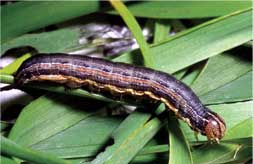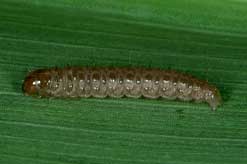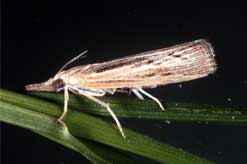It is best to let the lawn go dormant during the hot, dry weather. When the grass is dormant though, there are still a few things to watch out for such as insects and foot traffic.
 Lawn showing signs of drought
Lawn showing signs of drought
Photo Purdue University
- Of all the plants in the landscape, grass is the one that can go the longest without water, usually up to six weeks for a healthy lawn. Once you’ve decided to allow the lawn to go dormant, let it happen. An occasional, shallow watering during a drought will zap resources from the roots, energy the plant needs to stay alive. The grass will start to develop new leaves, only to have them die off when watering stops and dry conditions return.
If you must irrigate, do so infrequently and deeply, applying about 1 inch of water every week to 10 days. The water may be administered one-half inch at a time or all at once. Place a straight-sided container in the landscape and when it contains the amount of water desired, the job is done.
- Avoid walking on dormant lawns. Foot traffic and landscape equipment will crush the dry, delicate crowns, possibly damaging or killing the grass.
- When grass goes dormant, it turns brown and crispy. Because it is not growing, you won’t have to mow as often, if at all. If you do need to mow, keep the grass at least 3 inches tall.
- Don’t use fertilizer in the summer. It may stress the lawn, pushing growth that cannot be supported by the root system or water availability.
- Apply a broadleaf weed killer in late August, if needed.
Even though the lawn is dormant, the grass may be susceptible to damage from insects, such as fall armyworms, sod webworms or grubs.
Fall armyworms
Fall armyworms (Spodoptera frugiperda) can be damaging to lawns under stress. The larval stage of a small moth, fall armyworms vary from green to brown or black, with a dark head, marked by an inverted Y on the face and a stripe on each side. The caterpillar is about 1 inch long.
 Fall armyworm
Fall armyworm
© Purdue University
 Fall armyworm moth
Fall armyworm moth
© Henderson State University
Sod webworms
There are several species of caterpillars called sod webworms. If there are a lot of birds pecking in the lawn, look for the worms or moths. There will be spotted caterpillars about three-fourths of an inch long or dull, buff or gray moths about three-fourths of an inch long. The moths usually are facing downward on a blade of grass or flying in a zigzag pattern in the air. Large infestations can do a lot of damage to a lawn already under stress.
 Sod webworm
Sod webworm
© Purdue University
 Sod webworm moth
Sod webworm moth
© North Carolina State University
Grubs
If your grass had large brown spots at the end of last summer, sections of the lawn lifted like a piece of carpet from the ground, or you noticed skunks digging in the lawn, chances are your lawn had grubs. If you had any of these signs of grub damage last year, treat the lawn this year.
 White grub
White grub
© Purdue University
 White grubs in the soil
White grubs in the soil
© Purdue University
What to do
The best defense against a grub infestation is a healthy, vigorous, well-watered lawn, but if you need to treat for an infestation of grubs, Japanese beetles, or other insects, the solution is often to apply products like insecticides which can both prevent and remove the damage caused by these intruders. Be sure to check both the product package label or your county extension agent to be sure any grub-control product will be compatible with your lawn.